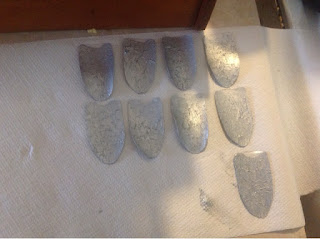LARP Scale Armour (Part 2)
At the end of part 1, we were cutting up 150-odd scales out of a dozen soft drink bottles. Not sure whether this would be enough (but seriously suspecting it wouldn't be).
The next stage is to get these scales to stop looking like cut out pieces of plastics, and instead make them look like polished pieces of metal, or insect chitin, or some other material from which our armour is made (in the context of the game) at the moment, this project is proof of concept, so I'm taking a deliberately simple course of action. I've considered that later repetitions of this armour might see every scale painted with a dark green vein, then lighter green to represent a series of leaves, but for the moment, a simple silver will suffice.
Painting Step
The silver needs to be protected from the hits of the swords, so I'm going to use one of the properties of the material to it's advantage...that being its transparency. I'm going to paint the underside of the scales. Thus giving a nice silvery colour, a protective layer of clear plastic on top of it, and a shiny gloss that many silver paints don't naturally give.
From the front, they look more shiny and metallic. Not mirrored, I've got my eye on a can of chrome spray paint for that effect on a future project, but metallic enough for my purposes, and certainly more metallic looking than the actual material (cut out sections of a PET soft drink bottle.
Preparation of Pattern
The next stage involves linking the scales together. I'm going to use the simplest method I can think of, with an old hoodie that I was planning to throw away... well, actually, my wife was planning to throw it away because I never throw much of anything away. The aim is to give an old piece of clothing a new lease of life, as a structural element for the scales.
The first thing to do is lay out a pattern.
Remember that in the first post I said that I already had the torso and abdomen covered by plates of armour that I'd made previously. I've also got some good leather gauntlets/vambraces that I've used over the years. So these scales basically just cover the upper arms and shoulders.
The next step is to measure the markings on the hoodie that I'll be sewing the scales to.
Then begins the slow process of sewing the scales, row by row onto the hoodie.
The next stage is to get these scales to stop looking like cut out pieces of plastics, and instead make them look like polished pieces of metal, or insect chitin, or some other material from which our armour is made (in the context of the game) at the moment, this project is proof of concept, so I'm taking a deliberately simple course of action. I've considered that later repetitions of this armour might see every scale painted with a dark green vein, then lighter green to represent a series of leaves, but for the moment, a simple silver will suffice.
Painting Step
The silver needs to be protected from the hits of the swords, so I'm going to use one of the properties of the material to it's advantage...that being its transparency. I'm going to paint the underside of the scales. Thus giving a nice silvery colour, a protective layer of clear plastic on top of it, and a shiny gloss that many silver paints don't naturally give.
From the back, the scales don't look great, but they aren't meant to be looked at from the back anyway...
Preparation of Pattern
The next stage involves linking the scales together. I'm going to use the simplest method I can think of, with an old hoodie that I was planning to throw away... well, actually, my wife was planning to throw it away because I never throw much of anything away. The aim is to give an old piece of clothing a new lease of life, as a structural element for the scales.
The first thing to do is lay out a pattern.
Remember that in the first post I said that I already had the torso and abdomen covered by plates of armour that I'd made previously. I've also got some good leather gauntlets/vambraces that I've used over the years. So these scales basically just cover the upper arms and shoulders.
The next step is to measure the markings on the hoodie that I'll be sewing the scales to.
Then begins the slow process of sewing the scales, row by row onto the hoodie.





.png)

Comments